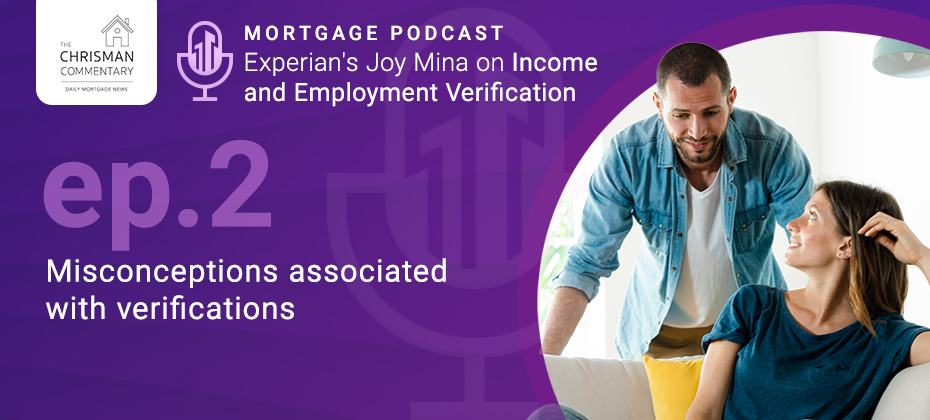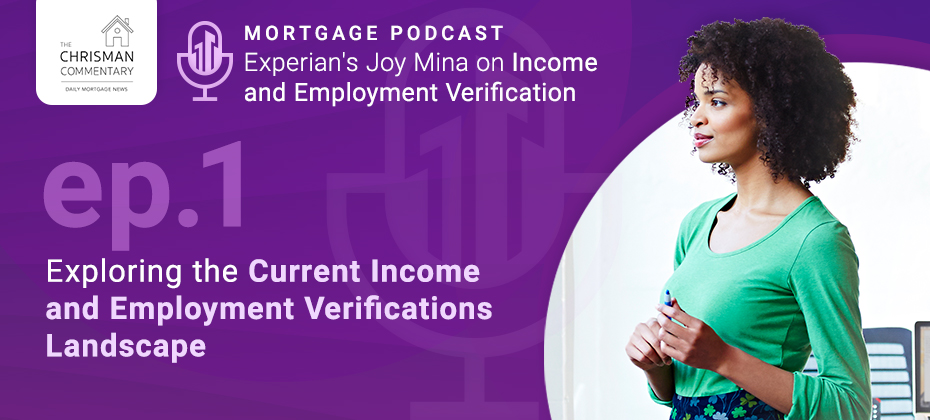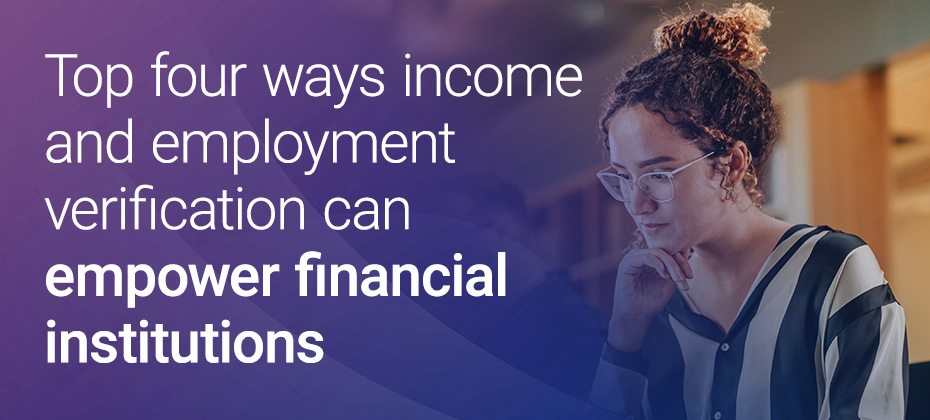Tag: income verification

In the previous episode of “The Chrisman Commentary” podcast, Joy Mina, Director of Product Commercialization at Experian, talked about the benefits of a waterfall strategy for income and employment verification. In the latest episode, Joy explores common misconceptions around verifications, such as how a lender needs to put a provider with the most records first in their waterfall. "While that might feel like a sure-fire way to cut costs, it isn't necessarily the most effective," said Joy. "Instead of comparing records, I would really encourage lenders to focus on a provider's total cost to verify a consumer." Listen to the full episode to learn about more misconceptions associated with verifications and what you can do to enhance your strategies. Listen to podcast Learn more

To say “yes” to consumers faster and more efficiently, financial institutions need flexible access to instant income and employment verification data. In an episode of “The Chrisman Commentary” podcast, Joy Mina, Director of Product Commercialization at Experian, talks about how income and employment verification has changed since Experian entered the market, the benefits of a waterfall strategy, and what’s next in our verifications journey. “Back then, we were hearing lenders primarily asking for more innovative solutions,” said Joy. “They wanted more flexibility without sacrificing quality of service.” Listen to the full episode to learn more about what lenders look for in an income and employment verification solution and how Experian VerifyTM is meeting these needs. Listen to podcast Learn more

Ensuring the reliability of tenant applications is paramount to running a successful property management business. But with an exponential rise in prospective residents using fake financial documents to inflate income and employment status, how do property managers navigate and detect fake paystubs without stepping on a landmine of liability? The marketplace of deception Paystub generator websites As you embrace the commitment to diligence, be aware that some legitimate websites can be unknowingly used by fraudsters to create counterfeit financial documents. Knowledge is your ally here. At the touch of a button, even the minimally tech inclined can produce pay stubs that appear convincing. There are dozens of sites that offer paystub generator software, including: Design and editing software websites that are accessible to people beyond just creative professionals. Popular e-commerce platform stores that host apps capable of creating paystubs. Mobile app stores that allow users to download apps for use on all major mobile devices. Key indicators of a fake paystub Remember, as a property manager or owner, you are responsible for scrutinizing these documents to protect your business interests. Use your awareness to be vigilant, verifying every piece of information to ensure the credibility of prospective tenants. While some of these falsified paystubs may appear to be legitimate, they are usually not perfect. Here are some quick checks which may help you spot a fake or trigger a deeper review quickly. Watch out for elusive typos Erroneous spelling, particularly in company names and financial terms, is a big red flag. Keep your eyes peeled for these unruly characters. Distorted watermarks A legitimate paystub should carry official watermarks or specific symbols that indicate its authenticity. However, be on the lookout for watermarks that seem off — sometimes, they're too conspicuous or amateurish, which can be a tell-tale sign of forgery. Authentic watermarks should be subtle and consistent with the company's brand. Crunching the numbers Inaccurate calculations can unravel a fake paystub. If the numbers just don't add up or pay dates vary inexplicably, you should investigate further. Inconsistent font Professional payroll systems stick to a consistent font. If you notice various font styles and sizes, it's worth investigating further. Authenticity lies in uniformity. Going logo-less? A missing company logo, or one that looks like it was copied from a low-resolution image on the internet, should trigger suspicion. Unusual tax deductions Abnormal tax deductions could indicate someone's fiddling with the figures. Brush up on your tax knowledge or consult with an expert if something seems off-the-wall. Final food for thought Remember, having the right knowledge and tools empowers you to make informed decisions, safeguarding your property from potential fraudsters. Be diligent, stay informed, and leverage technology to support your processes. Action steps to take today Educate your team: Make sure everyone involved in the application review process knows what to look for. Develop a standard operating procedure: Update your existing (or develop) Standard Operating Procedures: As new ways of gaming the system arise, make sure your particular procedures are keeping up with the times. For example, include steps for the following: Understand tenant screening laws in your area. Create consistent resident screening criteria. Check credit report and background. Verify employment and income. Review rental history and evictions (if any). Check criminal record with multi-state search. Interview residents before signing a lease. Follow a consistent policy when accepting or rejecting applicants. Embrace technology: Income and employment verification solutions can verify income directly from a trusted data source and avoid the paystub predicament altogether. Consider implementing a verification system that leaves no room for guesswork. Our verification solution, Experian VerifyTM, provides accurate, efficient, and compliant income and employment verification services. With Experian Verify, property managers can navigate the complexities of tenant-related income and employment verification with ease, ensuring they are adhering to Fair Housing laws and detecting fraudulent behavior. To learn more about how Experian Verify can benefit your property business, please contact us and visit us online. Learn more

As a community bank or credit union, your goal is to provide personalized care and attention to your customers and members while effectively managing regulatory requirements and operational efficiency. By incorporating tools such as income and employment verification, you can streamline the approval process for both account holders and prospects. With the ability to validate their information in seconds, you'll be able to make well-informed decisions faster and accelerate conversion. In this blog post, we will explore the empowering impact of income and employment verification on financial institutions. Better Data, Better Decisions Choosing a verification partner with an instant employer payroll network allows financial institutions to access reliable and up-to-date income and employment information for confident decision-making. With accurate and timely data at their fingertips, you can gain a deeper understanding of your account holders’ capacity to pay, a critical component to assessing overall financial health. This not only helps mitigate risk but also helps you serve your customers and members more effectively. There are additional benefits to partnering with a verification solution provider that is also a Credit Reporting Agency (CRA) offering FCRA-compliant technologies. These organizations are well versed in compliance matters and can help you more effectively mitigate risk. Streamline Approval Times and Remove Friction When developing your verification process, it is advantageous to adopt a waterfall or multi-step approach that encompasses instant verification, permissioned verification, and, as a last resort, manual verification. This tiered approach will significantly reduce approval times, manage costs effectively, and streamline the approval process. Instant verification relies on advanced technology to provide swift and efficient results. In cases where instant verification is unavailable, the process seamlessly transitions to permissioned verification, where explicit consent is obtained from individuals to access their payroll data directly from their respective providers. Lastly, manual verification involves collecting payroll and employment documents, which is a more time-consuming and costly process. By implementing this comprehensive approach, you can enhance the efficiency and effectiveness of your verification process while maintaining the integrity of the results. A Flexible Solution Community banks and credit unions are integral to the lending industry. It is crucial for them to select a versatile verification solution that can keep pace with the approval speed of both regional and large banks. Given that community banks and credit unions operate in smaller geographic regions compared to larger institutions, it is imperative for them to have a verification solution that is versatile and can be applied across their entire spectrum of loan offerings, including mortgage loans, automotive loans, credit cards, home equity loans, and consumer loans. This adaptability enables community banks and credit unions to consistently serve their account holders and enhances their ability to compete effectively with larger financial institutions. With a robust verification solution in place, community banks and credit unions can confidently navigate the complexities of the lending landscape and deliver exceptional results for their valued account holders. World-Class Service and Support To ensure a seamless verification journey, community banks and credit unions should choose a solution provider that delivers exceptional service and support. From the initial onboarding process and comprehensive training to ongoing troubleshooting and guidance, a dedicated and knowledgeable support team becomes indispensable in establishing a successful verification process. Having hands-on training and support not only instills peace of mind but also empowers community-focused financial institutions to consistently provide a high level of personalized service, fostering trust and loyalty among their customers and members. By investing in a robust support system, community banks and credit unions can confidently navigate the verification landscape and stay ahead in an ever-evolving financial industry, reinforcing their commitment to delivering an outstanding experience to their communities. As a longstanding leader in the financial industry, Experian understands the unique challenges faced by community banks and credit unions. Our verification solution, Experian VerifyTM, provides accurate, efficient, and compliant income and employment verification services. With Experian Verify, community focused financial institutions can navigate the complexities of income and employment verification with ease, achieving new levels of efficiency and success. To learn more about how Experian Verify can benefit your bank or credit union, we invite you to visit our website and schedule a personalized demo. Together, let's unlock the potential of income and employment verification and elevate your financial institution to new heights of success. Learn more

This article was updated on January 30, 2024. Income verification is a critical step in determining a consumer’s ability to pay. The challenge is verifying income in a way that’s seamless for both lenders and consumers. While many businesses have already implemented automated solutions to streamline operations, some are still relying on manual processes built on older technology. Let’s take a closer look at the drawbacks of traditional verification processes and how Experian can help businesses deliver frictionless verification experiences. The drawbacks of traditional income verification Employment and income verification provides lenders with greater visibility into consumers’ financial stability. But it often results in high-touch, high-friction experiences when done manually. This can be frustrating for both lenders and potential borrowers: For lenders: Manual verification processes are extremely tedious and time-consuming for lenders as it requires physically collecting and reviewing documents. Additionally, without reliable income data, it can be difficult for lenders to accurately determine a consumer’s ability to pay, leading to higher origination risk. For borrowers: Today’s consumers have grown accustomed to digital experiences that are fast, simple, and convenient. A verification process that is slow and manual may cause consumers to drop off altogether. How can this process be optimized? To accelerate the verification process and gain a more complete view of consumers’ financial stability, lenders must look to automated solutions. With automated income verification, lenders obtain timely income reports to accurately verify consumers’ income in minutes rather than days or weeks. Not only does this allow lenders to approve more applicants quickly, but it also enables them to devote more time and resources toward improving their strategies and enhancing the customer experience. The right verification solution can also capture a wider variety of income scenarios. With the click of a button, consumers can give lenders permission to access their financial accounts, including checking, savings, 401k, and brokerage accounts. This creates a frictionless verification experience for consumers as their income information is quickly extracted and reviewed. Retrieving data directly from financial accounts also provides lenders with a fuller financial picture of consumers, including those with thin or no credit files. This helps increase the chances of approval for underserved communities and allows lenders to expand their customer base without taking on additional risk.1 Learn more 1 Experian Income Verification Product Sheet (2017).

Signing new residents is not just about offering the right apartment home at the right price. Granted, that's obviously a huge part of the equation, but operators also need to provide prospective residents with a seamless shopping and leasing experience. If potential renters encounter any friction or hardships during this time, they are likely to take their home search elsewhere. Today's prospective renters want to be able to tour and gather information about apartments on their own time, and they want a quick "yes" or "no" after completing their lease application. With that in mind, automated income and employment verification - among other tools and solutions like self-guided and virtual tools, chatbots, and automated form fills, is one of the main features and technologies operators should consider implementing if they haven't already done so, to ensure we are meeting the renter where they are. Automated verification of identity, income, assets and employment For leasing managers, automated technology eliminates the need to manually collect the documents required to verify a prospect's self-reported information, which can be a tremendously time-consuming task that extends the overall leasing timeline and increases the exposure due to unoccupied units. Automated verification also reduces the opportunity for bad-faith applicants to submit fraudulent documents related to their financials or employment history. The best part about verification is the variety of options available; leasing managers can pick and choose verification options which meet their needs without breaking the tenant screening budget. Experian has multiple verification solutions and use cases to compare which one may work best for your community. The Experian difference To learn more about our suite of rental property solutions and ways we support the tenant screening process with data-driven insights, and verifications, please visit us at www.experian.com/rental. This article was originally published on MFI. Read more on MFI for a detailed look at additional tools and technologies operators should consider.

In today’s age, where speed and convenience are paramount, lenders must transform their digital income verification experience to meet customer expectations. Leveraging the benefits of instant verification is crucial to delivering a seamless experience. However, there are situations where instant verification may not be available or unable to verify customers. This is where the value of incorporating user-permissioned verification into your workflow becomes evident. Let’s explore the advantages of using a combination of instant and permissioned verification and how they can synergistically enhance coverage, reduce costs, improve efficiency, and deliver an exceptional customer experience. Instant verification: The epitome of efficiency and experience Instant verification technology enables lenders to access real-time customer data, making it the pinnacle of verification efficiency. Its ability to deliver immediate insights facilitates quick decision-making, ensuring a seamless and frictionless experience for lenders and customers. There are several benefits to streamlining your verification process, including: Speed and efficiency: Eliminate the time-consuming process of manually gathering and analyzing data to expedite loan approvals and reduce customer waiting times. Enhanced user experience: With real-time results, customers can complete their applications quickly and effortlessly, leading to increased satisfaction and higher conversion rates. Reduced risk: Assess applicant information promptly, maintaining the security and integrity of lending processes. Permissioned verification: Expanding coverage and engaging customers While instant verification technology offers numerous advantages, it may not always be available or suitable for every customer. This is where permissioned verification plays a vital role. By integrating permissioned verification into the verification workflow, lenders can expand coverage and keep customers engaged in a digital channel, reducing abandonment rates. The benefits of leveraging permissioned verification include: Convenience and speed: By granting permissioned access, customers avoid the hassle of uploading or submitting documents manually. This saves time and effort, resulting in a faster verification process. Increased coverage and reduced abandonment: Permissioned verification ensures a higher coverage rate by minimizing the potential for customer abandonment during the application process. Since the information is retrieved seamlessly, customers are more likely to complete the application without frustration. Privacy and control: Customers retain control over their data by explicitly granting permission for access. This enhances transparency and empowers individuals to manage their financial information securely. Creating a verification "waterfall" for optimal results To harness the combined power of instant and permissioned verification, lenders can establish a verification "waterfall" approach. This approach involves a cascading verification process where instant verification is the first step, followed by permissioned verification if instant verification is not available or unable to verify the customer. Example of Experian Verify’s automated verification waterfall. There are numerous advantages to adopting a “waterfall” approach, including: Cost efficiency: Lenders who prioritize instant verification save on operational costs associated with manual verification processes. The seamless transition to permissioned verification reduces the need for manual intervention, minimizing expenses and improving efficiency. Improved verification success rate: A verification waterfall ensures that alternative verification methods are readily available if the initial instant verification is unsuccessful. This increases the overall success rate of verifying customer data and reduces the likelihood of losing potential borrowers. Enhanced customer experience: The combination of instant and permissioned verification creates a streamlined and frictionless customer experience. Customers can progress seamlessly through the verification process, reducing frustration and increasing satisfaction levels. Propelling your business forward In the dynamic landscape of lending, a combination of instant and permissioned verification technologies provides significant value to lenders and customers. While instant verification delivers unparalleled efficiency and experience, incorporating permissioned verification ensures expanded coverage, reduced abandonment rates, and a seamless digital journey for customers. By implementing a verification "waterfall" approach, lenders can optimize verification processes, reduce costs, improve efficiency, and ultimately deliver an exceptional customer experience. Learn more about our solutions The advantages of instant and permissioned verification *This article leverages/includes content created by an AI language model and is intended to provide general information.

In the fast-paced world of lending and financial services, digital income verification processes play a crucial role in assessing customer eligibility and mitigating risk. However, not all verification methods are created equal. Let's delve into the differences between instant, permissioned, and manual income and employment verification, and their unique characteristics, benefits, and drawbacks. Instant verification: Real-time insights for seamless decision-making Instant employment and income verification is a game-changer in the lending industry. It provides immediate insights into a customer's financial information, allowing lenders to make real-time decisions. This real-time access to data streamlines the decision-making process, enabling lenders to deliver a seamless and frictionless customer experience. The advantages of instant employment and income verification include: Speed and efficiency: Instant verification eliminates the time-consuming process of manually gathering and analyzing data. This enables lenders to expedite loan approvals, reducing customer waiting times significantly. Enhanced user experience: By delivering real-time results, instant verification enhances the overall customer experience. Customers can complete their applications quickly and effortlessly, leading to increased satisfaction and higher conversion rates. Reduced risk: Real-time verification allows lenders to assess applicant information promptly, maintaining the security and integrity of lending processes. Permissioned verification: Empowering customers in their digital experience Permissioned verification gives customers the ability to grant access to their financial information directly from their payroll or bank accounts. This method is valuable because it keeps customers within their digital experience, eliminating the need for manual document submission or authentication. The benefits of permissions verification include: Convenience and speed: By granting permissioned access, customers can automate income verification and avoid the hassle of uploading or submitting pay stubs manually. This saves time and effort, resulting in a faster verification process. Increased coverage and reduced abandonment: Permissioned verification ensures a higher coverage rate by minimizing the potential for customer abandonment during the application process. Since the information is retrieved seamlessly, customers are more likely to complete the application without frustration. Privacy and control: Customers retain control over their data by explicitly granting permission for access. This enhances transparency and empowers individuals to manage their financial information securely. Manual Verification: A last resort with high friction Manual verification is a traditional method that involves time-consuming and costly processes. It requires lenders to manually collect, review, and verify documents provided by the customer. This method should be reserved as a last-ditch effort when instant and permissioned verification options are not feasible. There are several drawbacks to manual verification, including: Time-consuming: Manual verification involves significant manual labor, which leads to longer processing times. This delays loan approvals and can negatively impact the customer experience. High cost: The labor-intensive nature of manual verification incurs higher operational costs for lenders. These costs can potentially trickle down to customers in the form of higher fees. Increased friction: Customers must go through the inconvenience of gathering and submitting physical documents, potentially hindering the overall loan application process. Level-up your verification experience The differences between instant, permissioned, and manual verification are important to understand. As technology continues to evolve, instant and permissioned verification methods are poised to become the norm, transforming lending processes and fostering greater efficiency and customer satisfaction. Lenders must embrace these innovative verification methods to stay ahead in the competitive financial landscape and provide an exceptional digital income verification experience for their customers. To learn how Experian can help you transform your verification experience, visit us as experian.com/verify. *This content has been created by an AI language model and is intended to provide general information.

In previous posts, I’ve explored the potential ramifications of the end of the Public Health Emergency (PHE) and how it will impact agency plans such as Medicaid eligibility redeterminations. Many states may have already prepared a risk-based approach to address the unwinding process. States need to balance these plans with onboarding new applicants and maintaining the service levels required by the Centers for Medicare & Medicaid Services (CMS). Regardless of the approach, states should look for efficiency in all aspects of the redeterminations process, including aligning pending work with other program recertifications and maximizing the use of available information and tools. What does the end of the PHE mean for state agencies? From the end of the PHE, state agencies will have 12 months to initiate all citizen eligibility renewals and a total of 14 months to complete them. States may begin the unwinding process 60 days prior to the month in which the PHE ends. Many states have already begun Medicaid eligibility redeterminations in an effort to meet this deadline. CMS has provided extensive guidance in their Planning for Resumption document, which state agencies can refer to for full details. Building a proper redeterminations plan Redeterminations plans should verify citizen information with all available information, including residency, age, income, and deceased status. These plans should also support the assessment of identity risk and have the ability to ensure continuous outreach with accurate mailing addresses, phone numbers for calls and texts, email addresses, and assessments of returned mail. CMS guidance encourages states to verify eligibility requirements by mail, email, and other communications channels while minimizing the amount of time and documentation required of beneficiaries. The benefit of standing up this structure? More effective day-forward solutions that can help agencies assess any new and ongoing benefits requests and maintain accurate eligibility lists. How can Experian help? Experian® has a range of products designed to help organizations verify contact information, such as phone numbers and mailing addresses, as well as income and employment. Our exclusive income and employment data can be leveraged incrementally in non-automated verification methods so that individuals not found by other services can be processed quickly via batch processing — minimizing any impact to beneficiaries while improving overall program performance. Our address verification tools provide improved outreach to beneficiaries with the best and most accurate mailing addresses, leveraging the National Change of Address (NCOA) database, as well as phone number information. The phone number information includes a mobile phone indicator, enabling text message outreach. Additionally, Experian can provide email address provisioning to verify or provide email addresses, which creates another path for contact. All of this helps agencies develop better redeterminations plans to manage the end of the PHE, and better process future benefits requests. To learn more about how we can help, visit us or request a call.

Believe it or not, 2023 is underway, and the new year could prove to be a challenging one for apartment operators in certain ways. In 2021 and into the beginning of 2022, demand for apartment rentals approached record levels, which shrunk vacancy rates and increased monthly rents. The rest of the year remained stagnant while other regions saw some decline, but inflation and other economic factors have many apartment communities confronted with labor shortages, and other challenges which can certainly make leasing and operating properties difficult. Against that backdrop, here are some of the technologies and solutions operators should consider for optimizing their success and efficiencies in 2023 and beyond. Tools that allow prospective residents to have a fully digital and contactless leasing experience — During the pandemic, many operators rushed to implement virtual tours, onsite self-guided tours and other solutions that allowed prospects to apply for and finalize their leases remotely. Prospective renters have undoubtedly grown fond of navigating the leasing process from their homes and taking self-guided tours when onsite, and the demand for digital solutions will surely continue even after COVID distancing is no longer a factor. Therefore, apartment owners and operators should think of these capabilities as long-term investments and always seek ways to optimize the digital leasing experience they provide. Along those lines, forward-thinking operators are employing solutions that allow them to embed credit functionality into their websites and mobile apps using modern, RESTful APIs like the Experian ConnectSM API. Not only does it enhance the information included in a lease application with credit report data, but it also allows prospective renters to easily apply for more than one property at once, enhancing their experience at the same time. Automated lease application form fill — By using information entered by a lease applicant (such as first name, last name, postal code and the last four digits of a Social Security number), this technology uses information from credit files to automatically fill other data fields in a lease application. This tool reduces the effort required by prospective renters to complete the application process, resulting in a better user experience, faster completions, greater accuracy and reduced application abandonment. Automated verification of income, assets, and employment — These solutions eliminate the need for associates to manually verify these components of a lease application. Manual verification is both time-consuming and prone to human error. In addition, automated tools eliminate the opportunity for applicants to supply falsified supporting documentation. The best part about verification is the variety of options available; leasing managers can pick and choose verification options that meet their needs. Renter Risk Score™ and custom-built scores and models applying RentBureau data — These options offer a score designed expressly to predict the likelihood that an applicant will pay rent. Renter risk score can be purchased with preset score logic, or for high-volume decisions, a model can be built calibrated for your specific leasing decisioning needs. A rental payment history report — The RentBureau Consumer Profile tool can provide detailed insight into a lease applicant's history of meeting their lease obligations, which is invaluable information during the lease application process. Having a tool to report rental payment histories to credit bureaus can be a powerful financial amenity. By reporting these payments, operators can help residents build credit histories and improve financial well-being. Such an amenity can attract and retain residents and provide them with a powerful incentive to pay rent on time and in full. In the end, tools that seek to manage risk and create improved experiences for prospective renters have a multitude of benefits. They create meaningful efficiencies for onsite staff by greatly reducing the time, resources and paperwork required to process applications and verify applicant information. This gives overextended associates more time to handle their many other responsibilities. Beyond just efficiency savings, these technologies and solutions also can help operators avoid the complications and loss of income that result from evictions. In fact, the National Association of Realtors estimates that average eviction costs $7,685. Managing risk and providing the best possible customer experience should always be top of mind for rental housing operators. And with the solutions outlined above, they can effectively accomplish those goals in 2023 and beyond.

Today's top lenders use traditional and alternative credit data1 – or expanded Fair Credit Reporting Act (FCRA) regulated data – including consumer permissioned data, to enhance their credit decisioning. The ability to gain a more complete and timely understanding of consumers' financial situation allows lenders to better gauge creditworthiness, make faster decisions and grow their portfolios without taking on additional risk. Why lenders need to go beyond traditional credit data Traditional credit data is — and will remain — important to understanding the likelihood that a borrower will repay a loan as agreed. However, lenders who solely base credit decisions on traditional credit data and scores may overlook creditworthy consumers who don't qualify for a credit score — sometimes called unscorable or credit invisible consumers. Additionally, they may be spending time and money on manual reviews for applications that are low risk and should be automatically approved. Or extending offers that aren't a good fit. What is consumer permissioned data? Consumer permissioned data, or user permissioned data, includes transactional and account-level data, often from a bank, credit union or brokerage account, that a consumer gives permission to view and use in credit decisioning. To access the data, lenders create secure connections to financial institutions or data aggregators. The process and approach give consumers the power to authorize (and later retract) access to accounts of their choosing — putting them in control of their personal information — while setting up security measures that keep their information secure. In return for sharing access to their account information, consumers may qualify for more financial products and better terms on credit offers. What does consumer permissioned data include? Consumers can choose to share different types of information with lenders, including their account balances and transaction history. While there may be other sources for estimated or historic account-level data, permissioned data can be updated in real-time to give lenders the most accurate and timely view of a consumer's finances. There is also a wealth of information available within these transaction records. For example, consumers can use Experian Boost™ to get credit for non-traditional bills, including phone, utility, rent and streaming service payments. These bills generally don't appear in traditional credit reports and don't impact every type of credit score. But seeing a consumer's history of making these payments can be important for understanding their overall creditworthiness. What are the benefits of leveraging consumer permissioned data? You can incorporate consumer permissioned data into custom lending models, including the latest explainable machine learning models. As part of a loan origination system, the data can help with: Portfolio expansion Accessing and using new data can expand your lending universe in several ways. There are an estimated 28 million U.S. adults who don't have a credit file at the bureaus, and an additional 21 million who have a credit file but lack enough information to be scorable by conventional scoring models. These people aren't necessarily a credit risk — they're simply an unknown. Increased insights can help you understand the real risk and make an informed decision. Additionally, a deeper insight into consumers' creditworthiness allows you to swap in applications that are a good credit risk. In other words, approving applications that you wouldn't have been able to approve with an older credit decision process. Increase financial inclusion Many credit invisibles and thin-file applicants also fall into historically marginalized groups.2 Almost a third of adults in low-income neighborhoods are credit invisible.3 Black Americans are much more likely (1.8 times) to be credit invisible or unscorable than white Americans.4 Recent immigrants may have trouble accessing credit in the U.S., even if they had a good credit history in their home country.5 As a result, using consumer permissioned data to expand your portfolio can align with your financial inclusion efforts. It's one example of how financial inclusion is good for business and society. Enhance decisioning and minimize risk Consumer-permissioned data can also improve and expand automated decisions, which can be important throughout the entire loan underwriting journey. In particular, you may be able to: Verify income faster: By linking to consumers’ accounts and reviewing deposits, lenders can quickly verify their income and ability to pay. Make better decisions: Consumer permissioned data also give lenders a new lens for understanding an applicant’s credit risk, which can let you say yes more often without taking on additional risk. Process more applications: A better understanding of applicants’ credit risk can also decrease how many applications you send to manual review, which allows you to process more applications using the same resources. Increase customer satisfaction: Put it all together, and faster decisions and more approvals lead to happier customers. While consumer permissioned data can play a role in all of these, it's not the only type of alternative data that lenders use to grow their portfolios. What are other types of alternative data sources? In addition to consumer permissioned data, alternative credit data can include information from: Alternative financial services: Credit data from alternative financial services firms includes information on small-dollar installment loans, single-payment loans, point-of-sale financing, auto title loans and rent-to-own agreements. Rental agreement: Rent payment data from landlords, property managers, collection companies and rent payment services. Public records: Full-file public records go beyond what’s in a consumer’s credit report and can include professional and occupational licenses, property deeds and address history. Why partner with Experian? As an industry leader in consumer credit and data analytics, Experian is continuously building on its legacy in the credit space to help lenders access and use various types of alternative data. Along with Experian Boost™ for consumer permissioned data, Experian RentBureau and Clarity Services are trusted sources of alternative data that comply with the FCRA. Experian also offers services for lenders that want help understanding and using the data for marketing, lending and collections. For originations, the Lift Premium™ credit model can use alternative credit data to score over 65% of traditionally credit-invisible consumers. Expand your lending universe Lenders are turning to new data sources to expand their portfolios and remain competitive. The results can provide a win-win, as lenders can increase approvals and decrease application processing times without taking on more risk. At the same time, these new strategies are helping financial inclusion efforts and allowing more people to access the credit they need. Learn more 1When we refer to “Alternative Credit Data," this refers to the use of alternative data and its appropriate use in consumer credit lending decisions, as regulated by the Fair Credit Reporting Act. Hence, the term “Expanded FCRA Data" may also apply in this instance and both can be used interchangeably.2-5Oliver Wyman (2022). Driving Growth With Greater Credit Access

Earlier this year, I explored the potential impact of the end of the current Public Health Emergency (PHE). The U.S. federal government has been operating under a PHE for COVID-19 for more than 30 consecutive months since it was initially announced in January 2020. On July 15, 2022, this PHE was renewed for a tenth time. Following this latest extension, the Centers for Medicare & Medicaid Services (CMS) has released a roadmap for the end of the COVID-19 PHE. In a related blog, they reiterate the commitment to provide a 60-day notice prior to the end of the PHE, but urge states and healthcare providers to prepare for the end “as soon as possible.” With these upcoming changes in mind, I wanted to review key areas for providers to consider as they prepare for the end of the PHE. Enrollments continue to increase, putting state budgets at risk From the start of the PHE in February 2020 through April 2022, Medicaid/Children’s Health Insurance Plan (CHIP) enrollment has increased by more than 17M people and this is affecting every state. Nearly half of all states have experienced an increase of more than 25% during this time period, with some experiencing increases of more than 40%. Given an average Medicaid cost to states of more than $8.4K per capita, that translates to an increase of billions of dollars. Once the PHE expires, states will have 12 months to redetermine eligibility for continued enrollment in the program, or risk bearing 100% of the associated cost. Preparing for the end of the PHE To avoid unnecessary expenditures and ensure that citizens are receiving access to the correct services, states will have to conduct a holistic review of their Medicaid rolls to confirm eligibility. In CMS’s guidance for states to prepare for the end of the PHE, they recommend creating an automated process to handle this unprecedented review. With the right partner, agencies can perform redeterminations of their existing registration rolls, and prepare for future services requests. The right solution can allow citizens to easily apply for benefits, triggering the automatic, real-time pull of income and employment information so that the agency can verify eligibility. Experian is a trusted government partner that is ready to assist states with preparing and automating the process for redetermination of benefits. To learn more about how Experian can assist with citizen benefit redetermination and registration efforts, visit us or request a call. Learn more

Last year, my wife and I decided to take advantage of Experian’s remote-work policy and move back to my hometown, so we could be closer to family and friends. As excited as we were, the idea of selling and buying a home during the market frenzy was a little intimidating. Surprisingly, finding a home wasn’t our challenge. We lucked out and found what we were looking for in the exact neighborhood we wanted. Our biggest challenge was timing. Our goal was to sell our current home and immediately move into the new one, with no overlap of payments or having to put our belongings in storage while we temporarily stayed with family (or in a short-term rental). Once we sold our home, we had exactly 30 days to close on our new home and move in. Since this wasn’t our first rodeo, I felt confident all would go smoothly. Things were on schedule until it came time to verify our income and employment. Who knew something so simple could be so hard? Let me share my experience with you (crossing my fingers you have a smoother experience in place for your borrowers): Pay statements — I was initially asked to provide pay statements for the previous two months. Simple enough for most borrowers, but it does require accessing your employer payroll system, downloading multiple pay statements and then either uploading them to your lender portal or emailing them to your loan officer (which no borrower should be asked to do). This took me less than 30 minutes to pull together. Verification report — After reviewing my pay statements, my lender told me they needed an official verification report on my current and previous employers. At the time, Experian had just acquired Corporate Cost Control (now part of Experian Employer Services), a company that offers verification-fulfillment services for employees, employers and verifiers. I told my lender I could provide the verification report via Corporate Cost Control and they agreed it would be sufficient. This took me several days to figure out. HR information — Just when I thought we were good, I received an email from my lender asking for one last thing — the HR contact information of my current and previous employers. Obtaining this information from Experian was easy, but I didn’t know where to start with my previous employer. I ended up texting some former colleagues to get the information I needed. This too took several days to figure out. Finally, I got the call from my lender saying everything checked out and I was good to proceed with the underwriting process. Whew! What I thought would take 30 minutes ended up taking a full week and threatened our ability to close on time. And not to mention was a massive headache for me personally. This isn’t how you want your borrowers to feel, which brings me to the title of this blog, it’s 2022, why is mortgage employment verification so painful in today’s digital age? Other industries have figured out how to remove pain and friction from their user experiences? Why is the mortgage industry lagging? Mortgage employment verification made easy If it’s lack of awareness, you should know there are tools that can automate verification decisions. Experian Verify™ is a perfect example where mortgage lenders can instantly verify a borrower’s income and employment information (both current and previous employers), without needing to ask the borrower to track down pay statements or HR contact information. You can literally verify information in seconds — not hours, days, or weeks. And the service supports Day 1 Certainty® from Fannie Mae — giving you increased peace of mind the data is accurate and trusted. This not only improves the borrower experience but increases efficiency with your loan officers. Tools like Experian Verify are a win-win for you and your borrowers. So, what are you waiting for? Modernize your experience and give your borrowers (like me) the frictionless experience they deserve, and if we’re being honest, are starting to demand. Learn more about income and employment verification for mortgage

Mortgage lenders are no stranger to income and employment verification. Leveraging a third-party solution provider for automated verifications is a standard practice in mortgage underwriting. Yet many lenders still struggle with time-consuming and complex verification experiences, which can be manual, inefficient and painful for borrowers. Since introducing Experian Verify™ to the market, we’ve had countless conversations with key players in the industry – from the largest banks to small independent mortgage brokers and everything in between. Through these conversations, we’ve learned quite a bit about some of the dos and don’ts when it comes to implementing a successful strategy for income and employment verification for mortgage. Lead with instant verification Digital transformation has forever changed borrower expectations for online experiences. The first key to a successful verification strategy is starting your workflow with an instant verification solution. This allows you to verify information in real time, delivering a completely frictionless experience for you and your borrowers. Consider building a waterfall process For instances when a borrower’s income and employment information is unable to be verified through an instant verification solution, add a consumer-permissioned (bank or payroll) option as a backup. Cascading from one digital solution to the next will ensure you can verify borrower information in seconds or minutes, as opposed to days or weeks. The goal is to prevent as many borrowers as possible from going through a costly manual process. Tap into unique data sources Many verification solutions in market today tap into the same data sources, which can make it difficult to differentiate between solutions and measure additive benefits. When evaluating options, look for verification solutions that leverage unique and exclusive data sources – allowing you to optimize hit rates and maximize value. Avoid a “one-size-fits-all” approach There is no silver bullet. Every market is unique and every lender has different needs. Your verification requirements are likely specific to your business, which means you need to leverage verification solutions that offer flexible options and enable you to build a verification experience that works best for you and your borrowers. Find a solution provider who’s all in It’s important to find a solution provider where income and employment verification isn’t just a “side hustle,” but is core to their business strategy. Find a provider who is fully committed – delivering new innovations, investing in key partnerships, maximizing accessibility through leading LOS / POS technology providers, and offers eligibility for key industry programs, such as Day 1 Certainty® from Fannie Mae. Challenge the status quo Many lenders have an existing relationship with a third-party solution provider. But it’s important not to put all your eggs in one basket. If your existing provider is not meeting all your needs, challenge the status quo. Consider adding a second provider to the top of your waterfall to help contain costs and tap into unique data that is not available from your existing provider. Ready for further insight? Learn more about income and employment verification for mortgage.

It's one thing to make a corporate commitment to financial inclusion, but quite another to set specific goals and measure outcomes. What goals should lenders set to make financial inclusion a reality? How can success be quantified? What actionable steps must be taken to put policy into practice? The road to financial inclusion may feel long, but this step-by-step checklist can help you measure diversity and achieve goals to become more inclusive as an organization. Step 1: Set quantifiable goals with realistic outcomes Start by defining what you plan to achieve with a financial inclusion strategy. When setting goals, Alpa Lally, Experian's Vice President of Data Business at Consumer Information Services, recommends organizations "assess the strategic opportunity at the enterprise level." "It is important that KPIs are aligned across each business unit and functional groups in order to understand the investment opportunity and what the business must achieve together," said Lally. "The key focus here is 'together', the path to financial inclusion is a journey for all groups and everyone must participate, be committed and be aligned to be successful." Figuring out your short- and long-term goals should be the first step to kickstarting a financial inclusion strategy. But equally important is driving towards outcomes. For instance, if the goal is to increase the number of loans made to previously overlooked or excluded consumers, you may want to start by examining your declination population to better understand who is being left out. Or if financial inclusion is tied to a wider strategy or vision on corporate social responsibility, your goals may include an education component, community outreach, and a re-examination of your hiring practices. No matter what KPIs you're using, here are relevant questions to ask in four key areas – which will help draw out your organizational goals and priorities: Organizational awareness: What action is your organization taking to enhance Diversity, Equity and Inclusion and embrace Corporate Social Responsibility (CSR) around financial inclusion? If you already have financial inclusion programs in place, what are the primary goals? Barriers: What barriers prevent the organization from pursuing equity, diversity and inclusion programs? Education: How do you create awareness and education around financial inclusion? Which community or third-party organizations can help you reach consumers who aren't aware of ways to access financial services? Markers of success: What benchmarks will your organization use to measure and analyze success? Step 2: Do a financial inclusion audit Before developing and implementing a robust financial inclusion program, Lally recommends conducting a financial inclusion audit – which is a "detailed assessment of where you are today, relative to the goals and results you've outlined". In a nutshell, it allows you to assess your current systems and results within your financial institution. According to Lally, a financial inclusion audit should address the following key areas: Roadmap: What are your strategic priorities and how will financial inclusion fit within them? Tracking: Track the actual volume and distribution of different underserved populations (e.g., young adults, low-income communities, immigrants, etc.) within your book of business. Look at the applications and the approval rates by segment. In addition, assess the interest rates these consumers are offered by credit score bands for each group: “Benchmarking is critical. Understanding how they compare to national averages? How do they compare to the rest of your portfolio?" said Lally. Hiring practices: Is diversity, equity and inclusion (DEI) central to your talent management strategy? Is there a link between a lack of DEI in hiring practices and the level of financial inclusion within an organization? Affordability and access: Determine if the products and services you offer are easily accessible, can be understood by a reasonable consumer and are affordable to a broad base. Internal practices: What policies exist that influence the culture and behavior of employees around financial inclusion? Partnerships: Identify outside organizations that can help you develop financial literacy programs to promote financial inclusion. Advertising: Does your advertising promote equal and diverse representation across a wide range of consumer groups? Tools to measure: Are you financially inclusive as a company? How can you improve? The Bayesian Improved Surname Geocoding (BISG) method used by the Consumer Financial Protection Bureau (CFPB) predicts the probability of an individual's race and ethnicity based on demographic information associated with the consumer's surname. Lenders can use this type of information to conduct internal audits or set benchmarks to help ensure accountability in their diversity goals. Step 3: Tap into technology New technology is emerging that gives lenders powerful tools to evaluate a wider pool of prospective borrowers while also mitigating risk. For instance, scoring models that incorporate expanded FCRA-regulated data provide greater insight into 'credit invisible' or 'unscorable' consumers because they look at a wider set of data assets (or 'alternative data'), which allows lenders to assess a larger pool of applicants. It also improves the accuracy of those scores and better assesses the creditworthiness of consumers. Consider these resources, among others: Lift Premium™: Experian estimates that lenders using Lift Premium™ can score 96 percent of U.S. adults, a vast improvement over the 81 percent that are scorable today with conventional scores relying on mainstream data. Such enhanced scores would enable six million consumers who are considered subprime today to qualify for “mainstream" (prime or near-prime) credit. Experian® RentBureau®: RentBureau collects rent payment data from landlords and management companies, which allows consumers to leverage positive rent payment history similarly to how consumers leverage consistent mortgage payments. Clarity Credit Data: Clarity Credit Data allows lenders to see how consumers use alternative financial products and examine payment behaviors that might exist outside of the traditional credit report. Clarity's expanded FCRA -regulated data provides a deeper view of the consumer, allowing lenders to identify those who may not have previously been classified as "at risk" and approve consumers that may have previously been denied using a traditional credit score. Income Verification: Consumers can grant access to their bank accounts so lenders can assess their ability to pay based on verified income and cash flow. In addition, artificial intelligence (AI) and greater automation can reduce operational costs for lenders, while increasing the affordability of financial products and services for customers. AI and machine learning (ML) can also improve risk profiling and credit decisioning by filling in some of the gaps where credit history is not available. These are just a few examples of a wide range of cutting-edge solutions and technologies that enable lenders to promote greater financial inclusion through their decisioning processes. As new solutions are introduced to the market, it is imperative that lenders look into these technologies to help grow their business. Step 4: Monitor and measure Measuring your progress on financial inclusion isn't a one-and-done proposition. After you've set your goals and created a roadmap, it's important to continue monitoring and measuring your progress. That means your performance to gauge the impact of financial inclusion at both the community and business levels. Lally recommends the following examples: Compare your lending pool to the latest population data from the United States census. Is your portfolio representative of the U.S. population or are there segments that should have greater access? How does it compare against other lenders competing in the same space? Keep in mind that it has been widely reported that certain populations were undercounted, so you may want to factor this reality into your assessments. Work to understand how traditionally underserved consumers are performing in terms of their payment behaviors, purchase patterns and delinquencies. Measure the impact of financial inclusion on your company's overall revenue growth, ROI and brand reputation. Conduct an analysis to better understand your company's brand reputation, how it's perceived across different groups and what your customers are saying. Last word Financial inclusion represents a big step towards closing the wealth gap and helping marginalized communities build generational wealth. Given the prevalence of socioeconomic and racial inequality in our country today, it's a complex issue that disproportionately impacts marginalized groups, such as consumers of color, low-income communities and immigrants. Adopting more financially inclusive practices can help improve access to credit for these groups. For financial institutions and lenders, the first step is to identify realistic, quantifiable goals. A successful financial inclusion initiative also hinges on completing a financial inclusion audit, tapping into the right technology and continually monitoring and measuring progress. "It is paramount that financial institutions hold themselves accountable and demonstrate their commitment to make these practices a part of their DNA." - Alpa Lally. Learn more